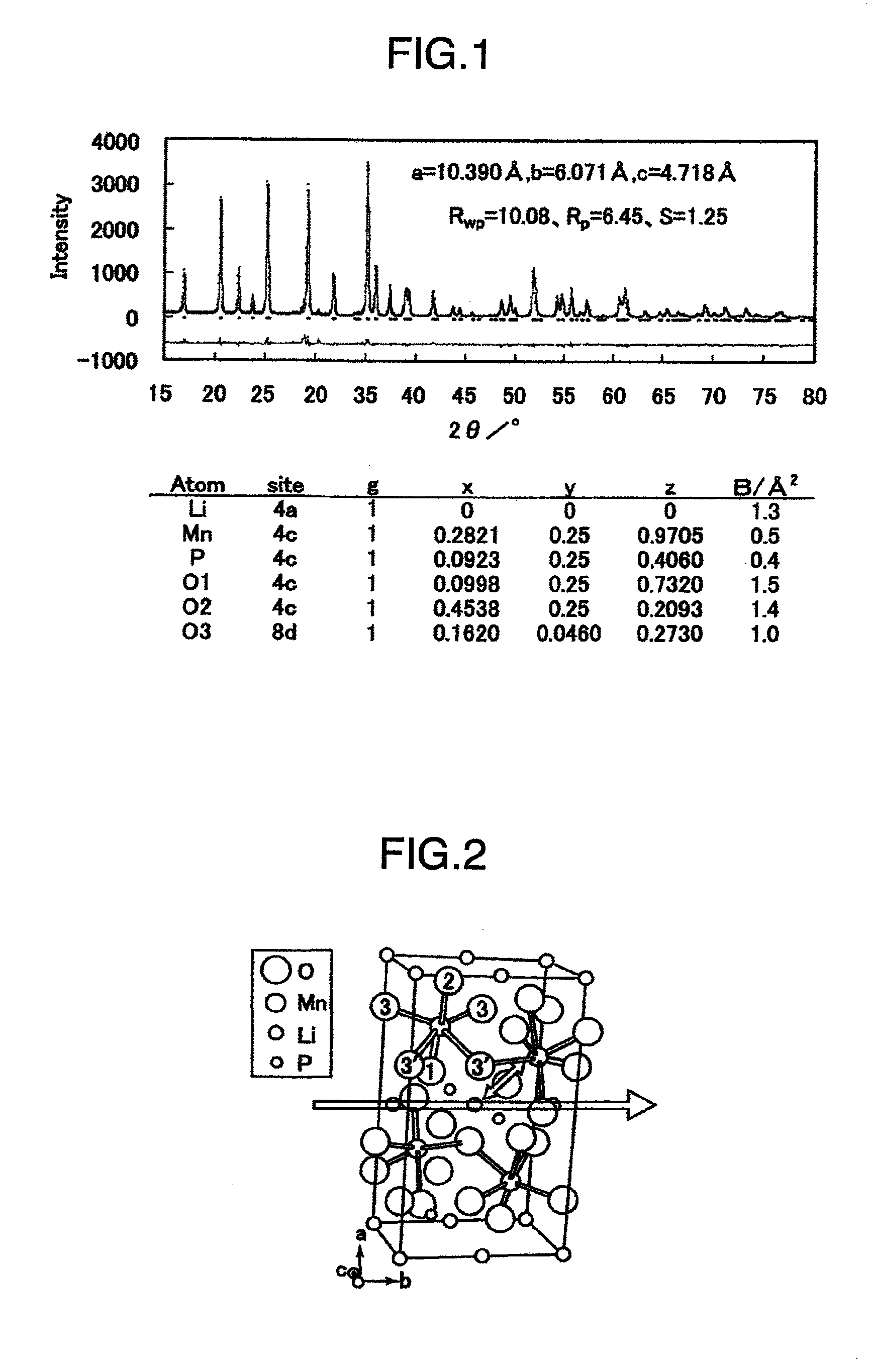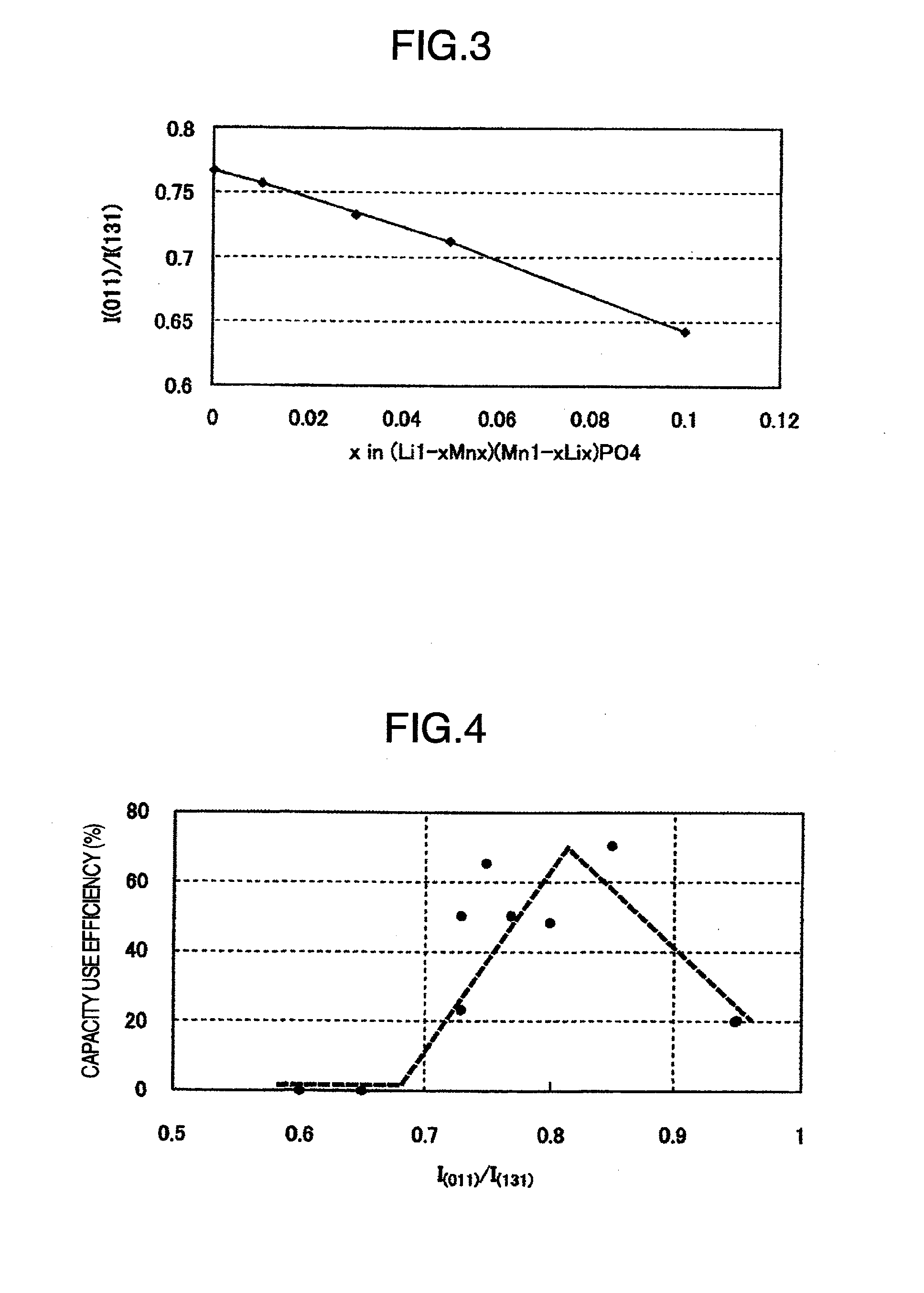Nonaqueous Electrolyte Secondary Batteries
a technology of non-aqueous electrolyte and secondary batteries, which is applied in the direction of non-aqueous electrolyte accumulator electrodes, cell components, electrical equipment, etc., can solve the problems of poor safety of lithium cobalt oxide batteries, increased cost of battery production and high cost of lithium cobalt oxide production, etc., to achieve the effect of improving the load characteristics of olivine limnpo4, high thermal stability and difficult metal melting
- Summary
- Abstract
- Description
- Claims
- Application Information
AI Technical Summary
Benefits of technology
Problems solved by technology
Method used
Image
Examples
example 1
LiMnPO4 / C (Dextrin)
[0063]Zirconium oxide balls for milling were placed in a zirconium oxide pot, and 2.675 g of LiH2PO4 (mfd. by Aldrich Chemical Co.), 4.373 g of MnC2O4.2H2O (mfd. by Pure Material Laboratory Ltd.) and 0.826 g of dextrin (mfd. by Wako Pure Chemical Industries Ltd.) were mixed for 30 minutes at a number of revolution of level 3 by the use of a planetary ball mill (mfd. by Fritsch). The resulting mixed powder was placed in an alumina crucible and first-sintered at 400° C. for 10 hours in an argon stream of 0.3 L / min. After the first-sintered powder was once pulverized in an agate mortar, it was placed in an alumina crucible and second-sintered at 700° C. for 10 hours in an argon stream of 0.3 L / min. The powder thus obtained was pulverized in an agate mortar and subjected to size control with a 45-μm mesh sieve to obtain the desired material.
[0064]Composition analysis was carried out by ICP method to find the followings: composition Li1.00Mn0.98P1.02O4, carbon content ...
example 2
LiMn0.96Ti0.03PO4 / C (Dextrin)
[0068]Synthesis and evaluation were carried out in the same manner as in Example 1 except for using as starting materials 2.684 g of LIH2PO4 (mfd. by Aldrich Chemical Co.), 4.295 g of MnC2O4.2H2O (mfd. by Kanto Chemical Co., Ltd.), 0.213 g of titanium tetraisopropoxide (mfd. by Kanto Chemical Co., Ltd.) and 0.823 g of dextrin (mfd. by Kanto Chemical Co., Ltd.). The results obtained are summarized in Table 1 and Table 2. Here, the capacity used at a voltage of 4.3 V or lower was dependent on the manganese content. For comparison with real capacity, the capacity use efficiency was calculated by taking a capacity at an efficiency of 100% as 170.9 mAh / g, as in [Example 1].
example 3
LiMn0.95Ti0.05PO4 / C (Dextrin)
[0069]Synthesis and evaluation were carried out in the same manner as in Example 1 except for using as starting materials 2.680 g of LIH2PO4 (mfd. by Aldrich Chemical Co.), 4.252 g of MnC2O4.2H2O (mfd. by Kanto Chemical Co., Ltd.), 0.350 g of titanium tetraisopropoxide (mfd. by Kanto Chemical Co., Ltd.) and 0.826 g of dextrin (mfd. by Kanto Chemical Co., Ltd.). The results obtained are summarized in Table 1 and Table 2.
PUM
 Login to View More
Login to View More Abstract
Description
Claims
Application Information
 Login to View More
Login to View More - R&D
- Intellectual Property
- Life Sciences
- Materials
- Tech Scout
- Unparalleled Data Quality
- Higher Quality Content
- 60% Fewer Hallucinations
Browse by: Latest US Patents, China's latest patents, Technical Efficacy Thesaurus, Application Domain, Technology Topic, Popular Technical Reports.
© 2025 PatSnap. All rights reserved.Legal|Privacy policy|Modern Slavery Act Transparency Statement|Sitemap|About US| Contact US: help@patsnap.com


